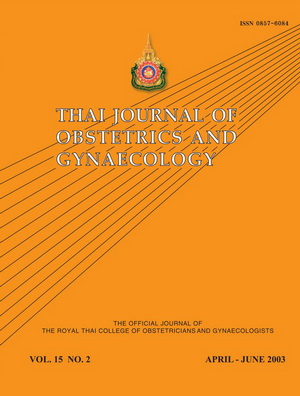Intraoperative Lymphatic Mapping and Sentinel Node Identification in Patients with Early Stage Cervical Cancer Undergoing Radical Hysterectomy and Pelvic Lymphadenectomy : A Pilot Study
Main Article Content
Abstract
Objective The purpose of this study was to determine the feasibility of sentinel lymph node
(SLN) identification in cervical cancer patients undergoing radical hysterectomy and pelvic
lymphadenectomy by using intraoperative lymphatic mapping with blue dye.
Design Descriptive study.
Setting Department of Obstetrics & Gynecology, Faculty of Medicine, Siriraj Hospital.
Methods Cervical cancer patients who underwent radical hysterectomy and pelvic lymphadenectomy were enrolled. During intraoperative period, patients without grossly suspected pelvic
lymph node metastasis will be injected with blue dye, 1% isosulfan blue dye (5 ml) intracervically
before any dissection. Ten minutes after dye injection, blue lymph vessels and lymph nodes
were identified and recorded. Blue lymph nodes (sentinel nodes) were dissected first and
followed by pelvic lymphadenectomy and radical hysterectomy. Blue lymph nodes (sentinel
nodes), other pelvic lymph nodes and uterus were sent separately for histologic examination
by routine hematoxylin & eosin staining (H&E).
Results Between June 2001 and January 2002, sixteen patients were enrolled, including 2
patients with stage IA2 and 14 patients with stage IB1. Median age was 45.9 years (33-62
years). Sentinel lymph nodes were identified in 12 of 16 patients (75%). A total of 34 lymph
nodes were identified clinically as sentinel nodes. The locations of sentinel nodes were 27
external iliac, 4 internal iliac and 3 obtulator node basin. Routine histologic examination showed
no lymph nodes metastasis in all nodes (sentinel and non-sentinel). No serious complication
was noted but transient decrease in oxygen saturation as measured by pulse oximetry was
detected in most patients but returned to normal within 3 hours after dye injection without any
cardiopulmonary compromise.
Conclusions Sentinel lymph node identification using intraoperative lymphatic mapping with blue
dye is feasible and safe. More patients are needed to determine the accuracy of this technique.
(SLN) identification in cervical cancer patients undergoing radical hysterectomy and pelvic
lymphadenectomy by using intraoperative lymphatic mapping with blue dye.
Design Descriptive study.
Setting Department of Obstetrics & Gynecology, Faculty of Medicine, Siriraj Hospital.
Methods Cervical cancer patients who underwent radical hysterectomy and pelvic lymphadenectomy were enrolled. During intraoperative period, patients without grossly suspected pelvic
lymph node metastasis will be injected with blue dye, 1% isosulfan blue dye (5 ml) intracervically
before any dissection. Ten minutes after dye injection, blue lymph vessels and lymph nodes
were identified and recorded. Blue lymph nodes (sentinel nodes) were dissected first and
followed by pelvic lymphadenectomy and radical hysterectomy. Blue lymph nodes (sentinel
nodes), other pelvic lymph nodes and uterus were sent separately for histologic examination
by routine hematoxylin & eosin staining (H&E).
Results Between June 2001 and January 2002, sixteen patients were enrolled, including 2
patients with stage IA2 and 14 patients with stage IB1. Median age was 45.9 years (33-62
years). Sentinel lymph nodes were identified in 12 of 16 patients (75%). A total of 34 lymph
nodes were identified clinically as sentinel nodes. The locations of sentinel nodes were 27
external iliac, 4 internal iliac and 3 obtulator node basin. Routine histologic examination showed
no lymph nodes metastasis in all nodes (sentinel and non-sentinel). No serious complication
was noted but transient decrease in oxygen saturation as measured by pulse oximetry was
detected in most patients but returned to normal within 3 hours after dye injection without any
cardiopulmonary compromise.
Conclusions Sentinel lymph node identification using intraoperative lymphatic mapping with blue
dye is feasible and safe. More patients are needed to determine the accuracy of this technique.
Article Details
How to Cite
(1)
Hanprasertpong, J.; Padungsutt, P.; Leelaphatanadit, C.; Thirapakawong, C. Intraoperative Lymphatic Mapping and Sentinel Node Identification in Patients with Early Stage Cervical Cancer Undergoing Radical Hysterectomy and Pelvic Lymphadenectomy : A Pilot Study. Thai J Obstet Gynaecol 2017, 15, 85-92.
Section
Original Article


